Guide to Uniforms and Suitable Figures for the Taiping Rebellion in China 1851-66
by John French
Taipings and Chinese Bandit Forces
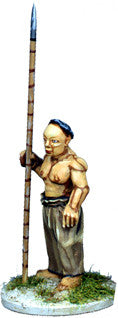 The shaven head and pigtail was considered an Imperialist symbol, so with very few exceptions they were not allowed, upon pain of death. Hair was grown long and either worn loose, tied on top of the head or wound into a plait, and tied with red or yellow thread. This was then wound around the head and the loose ends hung over the left shoulder. Colours for clothing usually bright silks & satins. Most Taiping followers wore a red turban or headscarf as a distinguishing feature but only soldiers and officials were allowed to wear red jackets. Yellow headscarves were worn by one set of bodyguards. Much less frequently turbans of other colours were used. Trousers black, red, blue or white. Units which did have uniforms were generally guard and veteran units. A short tunic with contrasting edges and white piping was worn over everyday clothing. In 1853 uniforms appear to have been yellow with edging in blue, green, red, black or white. Later colours included red edged yellow, white edged orange and black or purple edged in red. Soldiers could have white (less commonly yellow) identity patches on their tunic noting the soldiers unit on the front and religious slogan on the back. Writing on these was black. Some veteran units were also said to have worn all black. Otherwise soldiers wore a variety of looted silks and satins frequently highly coloured and patterned. Sashes red or yellow. Shoes when worn could be rope or leather sandals or wooden shoes. Women soldiers were formed into their own units, and some wore uniforms similar to the men, except that headscarves were yellow rather than red. Many colours were used, such as white and blue for stockings and red and blues with floral patterns for slippers. Officers (Wangs) usually dressed in red and yellow and rode horses in battle.
The shaven head and pigtail was considered an Imperialist symbol, so with very few exceptions they were not allowed, upon pain of death. Hair was grown long and either worn loose, tied on top of the head or wound into a plait, and tied with red or yellow thread. This was then wound around the head and the loose ends hung over the left shoulder. Colours for clothing usually bright silks & satins. Most Taiping followers wore a red turban or headscarf as a distinguishing feature but only soldiers and officials were allowed to wear red jackets. Yellow headscarves were worn by one set of bodyguards. Much less frequently turbans of other colours were used. Trousers black, red, blue or white. Units which did have uniforms were generally guard and veteran units. A short tunic with contrasting edges and white piping was worn over everyday clothing. In 1853 uniforms appear to have been yellow with edging in blue, green, red, black or white. Later colours included red edged yellow, white edged orange and black or purple edged in red. Soldiers could have white (less commonly yellow) identity patches on their tunic noting the soldiers unit on the front and religious slogan on the back. Writing on these was black. Some veteran units were also said to have worn all black. Otherwise soldiers wore a variety of looted silks and satins frequently highly coloured and patterned. Sashes red or yellow. Shoes when worn could be rope or leather sandals or wooden shoes. Women soldiers were formed into their own units, and some wore uniforms similar to the men, except that headscarves were yellow rather than red. Many colours were used, such as white and blue for stockings and red and blues with floral patterns for slippers. Officers (Wangs) usually dressed in red and yellow and rode horses in battle.
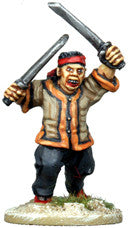 The most senior had yellow hoods, capes / jackets and gowns. The next most senior red hoods with broad yellow edging, yellow capes and red gowns. Capes could have dragon embroideries on them, boots also highly decorated. The dismounted Wang (Commanding Officer) in pack CH019 has a cap in either red or yellow cloth with much embroidery, including dragons and fancy patterns.
The most senior had yellow hoods, capes / jackets and gowns. The next most senior red hoods with broad yellow edging, yellow capes and red gowns. Capes could have dragon embroideries on them, boots also highly decorated. The dismounted Wang (Commanding Officer) in pack CH019 has a cap in either red or yellow cloth with much embroidery, including dragons and fancy patterns.
Incidentally most of these figures could be used as pirates of the Far East.
Numbers of cavalry were very small and usually comprised escorts to officers. Dress as for infantry.
Artillery: Use CH020 and also the odd piece from CMB005 to 9.
Clothing as for infantry. Brass castings with gun carriages typically red and black. Although most were 6 pdr. guns, the Taipings also used captured guns (some from EVA) and European pieces purchased from gun runners.

IMPERIALISTS
 Infantry: Bannermen were originally Manchu cavalrymen who had conquered China in 17th Century. By this period they were comprised of Manchus, Chinese and Mongols. Many now were foot soldiers, poorly paid, poorly trained and often placed in garrisons in small detachments. Many were stationed in or near Peking, whilst others were in walled towns of various provinces and in Manchuria and Turkestan. The Army of the Green Standard was not one army but were the 18 various provincial armies that were comprised of Chinese troops only. The size of each force varied greatly. Again they were split into small detachments which prevented a concentration of military power, but also made training impossible.
Infantry: Bannermen were originally Manchu cavalrymen who had conquered China in 17th Century. By this period they were comprised of Manchus, Chinese and Mongols. Many now were foot soldiers, poorly paid, poorly trained and often placed in garrisons in small detachments. Many were stationed in or near Peking, whilst others were in walled towns of various provinces and in Manchuria and Turkestan. The Army of the Green Standard was not one army but were the 18 various provincial armies that were comprised of Chinese troops only. The size of each force varied greatly. Again they were split into small detachments which prevented a concentration of military power, but also made training impossible.
Like Taipings tunics were usually worn over ordinary clothing. When trousers were provided they tended to be blue or white. Jackets were both with & without sleeves - most common colours were blue edged in red or red edged in white, although other combinations used. Soldiers of the Green Standard in 1855 wore black edged red. Bannermen at the Taku Forts wore brown edged pink. White circular patches on front & rear gave unit details. Hats were red crowns with black turned up brim.
Imperial Tigermen uniforms were yellow with black stripes in imitation of tiger. Shields in natural bamboo with stylised face of tiger with green eyes, red nostrils & inside of mouth, white teeth. Edges of shield black stripes.
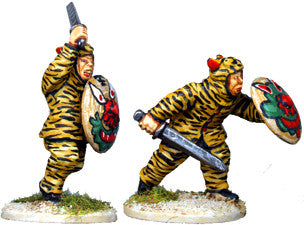
Cavalry tended to wear black Tartar boots. Otherwise similar colours to infantry.
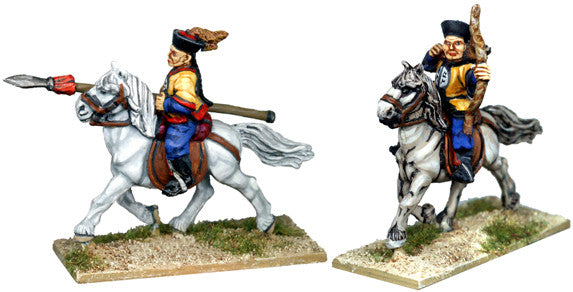
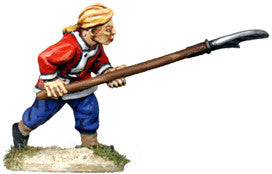 Imperialist Braves & ‘Brave Battalions’ were volunteers who drilled daily and were better paid than Green Standard’ troops. By the late 1850s they were the backbone of Imperialist armies. Following the fall of Nanking they almost WERE the army.
Imperialist Braves & ‘Brave Battalions’ were volunteers who drilled daily and were better paid than Green Standard’ troops. By the late 1850s they were the backbone of Imperialist armies. Following the fall of Nanking they almost WERE the army.
Turbans were standard colours for each unit - Huai Army wore mostly blue, red or black turbans; those from Szechwan & Yunnan provinces yellow, dark blue or scarlet; Imperialist troops of various times in white. Contemporary illus. show turbans and Imperial silk hats in use at the same time. Jingals were attached to each unit. There were few cavalry as the terrain did not lend itself to their use.
Mongolian Cavalry were frequently used by Chinese Government, some 10-15% of cavalry being Mongolian. Units could be 1,000 to 1,500 strong. Clothing mainly tanned leather and sheepskin, worn over kaftan which was often blue. Bowcases and horse furniture could be highly decorated

E.V.A. Infantry & Artillery
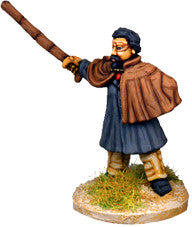 Turban green for whole of E.V.A. Bodyguard - uniform blue with red collar and cuffs. Green shoulder straps. White belts and black pouches. Infantry in winter dark green with scarlet facings and shoulder straps that were coloured according to regiment. Artillery wore light blue uniforms in winter with red collar, cuffs, shoulder straps and trouser stripe. In summer all the army changed into ‘white’ uniforms with red facings. Ward sometimes wore blue frock-coat but no military uniform. Gordon often wore Royal Engineer jacket of red with black facings, gold piping and a blue patrol jacket or frock-coat. American officers seem to have been distinctly non-uniformed, being described more as ‘buccaneers’.
Turban green for whole of E.V.A. Bodyguard - uniform blue with red collar and cuffs. Green shoulder straps. White belts and black pouches. Infantry in winter dark green with scarlet facings and shoulder straps that were coloured according to regiment. Artillery wore light blue uniforms in winter with red collar, cuffs, shoulder straps and trouser stripe. In summer all the army changed into ‘white’ uniforms with red facings. Ward sometimes wore blue frock-coat but no military uniform. Gordon often wore Royal Engineer jacket of red with black facings, gold piping and a blue patrol jacket or frock-coat. American officers seem to have been distinctly non-uniformed, being described more as ‘buccaneers’.
Officers from our Indian Mutiny range can also be used. Use British guns for the artillery.
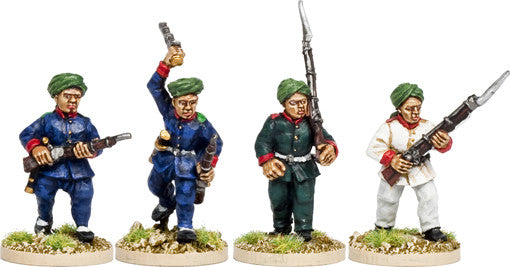
Shanghai Volunteers: Hat black with red band. Shirt red, trousers white, black leather equipment. Winter trousers were black with a red stripe. Unit was c.200 strong.
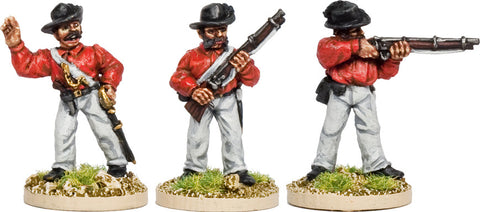
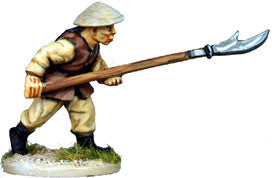 Chinese Militia: Formed for local defence of villages against attacks by bandits, they would also fend off attacks by Imperialists or Taipings. Usually armed with spears, polearms or bows with a scattering of muskets. Usually with coolie hats and civilian clothing.
Chinese Militia: Formed for local defence of villages against attacks by bandits, they would also fend off attacks by Imperialists or Taipings. Usually armed with spears, polearms or bows with a scattering of muskets. Usually with coolie hats and civilian clothing.
Kingsley’s Force: Figures same as for EVA.
This unit original about 500 strong in Oct. 1862 rose to around 1,100 by July 1863. They were Imperialist Chinese who were transferred to the British for training. They saw action alongside EVA. Black turbans, blue uniforms, white belts, black pouch.
Franco-Chinese Forces: Figures same as for EVA.
Turban red, blue & white stripes. Tunic white, probably edged in red. Trousers probably blue.

Click here for our article on the Taiping Rebellion in China 1851-66 by John French
Also see our section on the 2nd China War 1859-60 and Operations against the Taipings in the 1860s.
